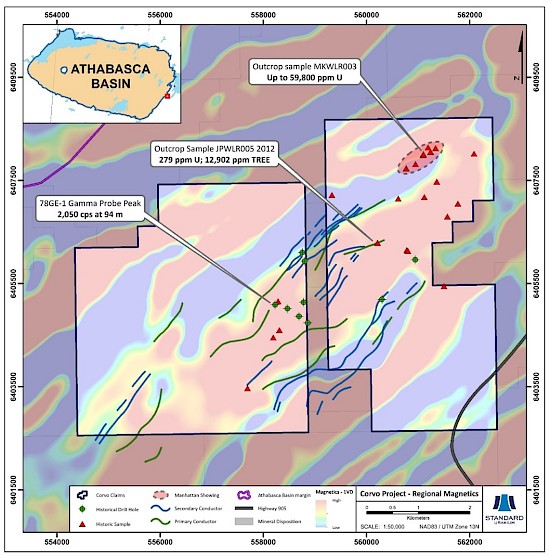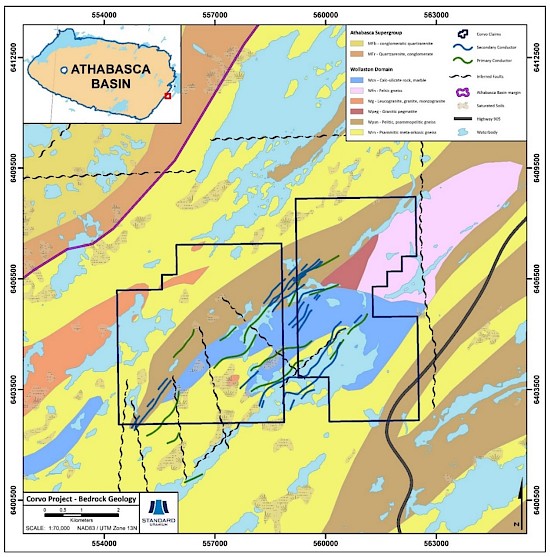Vancouver, British Columbia, August 18, 2023 — Standard Uranium Ltd. (“Standard Uranium” or the “Company”) (TSX-V:STND) (OTCQB: STTDF) (Frankfurt: FWB:9SU) is pleased to announce the appointment of Sean Hillacre as President, provide a corporate update on its exploration projects including announcing the expansion of the 100%-owned Sun Dog and Atlantic Projects and the expansion of the Company’s portfolio of highly prospective projects by the staking of the Corvo Project (the “Project”), totalling 3,711 hectares, in the eastern Athabasca Basin of northern Saskatchewan (Figure 1).
Jon Bey, CEO and Chairman for the Company, commented, “This summer has been challenging for many uranium junior exploration companies and investors. I believe we are going to see a much stronger second half of this year and our team has been quietly building our portfolio of projects and working on completing joint venture deals with new partners. I would also like to congratulate Sean Hillacre on his new role, Sean is a valued member of our team, and he will make a great President.”
With the addition of the Corvo Project (as described below) and expansion of the Sun Dog and Atlantic Projects, the Company now has ownership interests in seven projects, totalling over 176,969 acres across the uranium-rich Athabasca Basin. The Company continues to expand its set of high-potential assets across the Athabasca Basin to drive value and minimize dilution to shareholders through focused exploration and transactional success. The Company is seeking strategic partners to advance the projects through earn-in agreements that provide upside to shareholders through ongoing exploration and future discovery.
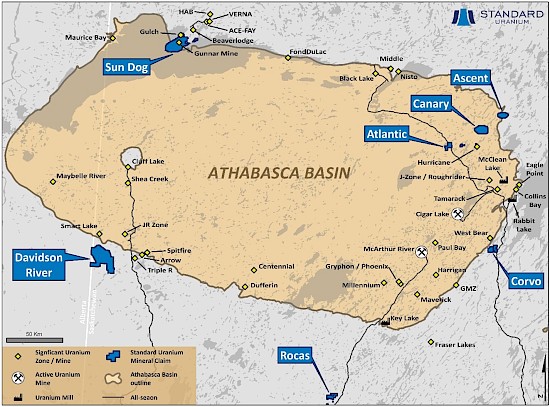
Corvo Project
The Corvo Project is situated 1.5 kilometres outside the current margin of the Athabasca Basin, approximately 50 kilometres southwest of Rabbit Lake mill facilities and 45 kilometres northeast of the Gemini Mineralized Zone (Figure 1).
The Corvo Project covers approximately 12 kilometres of two northeast trending magnetic low/electromagnetic (EM) conductor corridors (Figure 2). Data compilation by the Company is currently underway to identify target areas for high-grade1 uranium mineralization within metasedimentary and orthogneissic basement rocks (Figure 3). The Project will benefit from additional surface sampling and geophysical surveys to aid in drill target vectoring.
“As our technical team continues to expand our strategic land holdings in the Basin, the Corvo Project provides another opportunity for the Company to create value for shareholders through exploration of shallow targets for high-grade uranium,” said Sean Hillacre, President and VP Exploration for the Company. “Located just outside the present-day Basin margin along Highway 905, the logistics and geological setting of Corvo are ideal for discovery of an accessible and economic uranium deposit.”
[1] The Company considers uranium mineralization with concentrations greater than 1.0 wt% U3O8 to be “high-grade”.
Key Focus Points:
- Newly staked Corvo Project contains two strong NE-SW magnetic low trends coincident with EM conductors and cross-cutting faults.
- Historical surveys highlight geochemical anomalies along conductive trends and lithologic contacts observed in outcrop, including anomalous uranium values associated with elevated pathfinder and total rare earth elements (TREE).
- Elevated radioactivity measured in boulders, outcrop, and drilled rock coupled with the geochemical anomalies present on the Corvo project indicate high potential for uranium mineralization.
- Corvo is host to the previously discovered Manhattan Showing (Figure 2) having returned upwards of 59,800 ppm U with elevated Th, Pb, and TREEs and is in the vicinity of SMDI 2052 (0.137% U3O8 and 2,300 ppm Th).
Figure 3. Plan map showing regional bedrock geology of the Corvo project area and highlighting EM conductors coincident with cross-cutting faults.
The Company believes the Corvo Project is prospective for the discovery of shallow, high-grade basement-hosted uranium mineralization akin to that recently discovered at the Gemini Mineralized Zone. The staking of the Corvo Project is part of the Company’s strategy to increase its landholdings in the infrastructure-rich eastern Athabasca Basin of Saskatchewan, Canada. The project is also well positioned logistically, being road accessible via Highway 905 and proximal to other key infrastructure such as the Rabbit Lake Mill.
Atlantic Project
The Atlantic project consists of 7 mineral dispositions totalling 3,061 hectares, strategically located due west of IsoEnergy’s Hurricane Deposit (Figure 4). The project was acquired via staking in March 2019, and Standard Uranium holds a 100%-interest in the property. Atlantic has recently been expanded by 885 hectares, covering an additional 226 m of magnetic low/EM conductor strike length.
In June 2022, the Company completed a high-resolution ground gravity survey on the western claim block to identify subsurface density anomalies breaching the unconformity, potentially representing significant alteration zones. The Atlantic Project will require very little additional exploration before drill testing unconformity-related uranium target zones. Exploration efforts are focused on several high-priority target areas along several kilometres of mineralized conductors, coincident with cross-cutting faults and historical zones of elevated uranium in addition to favourable geochemical and geophysical anomalies identified through the current work.
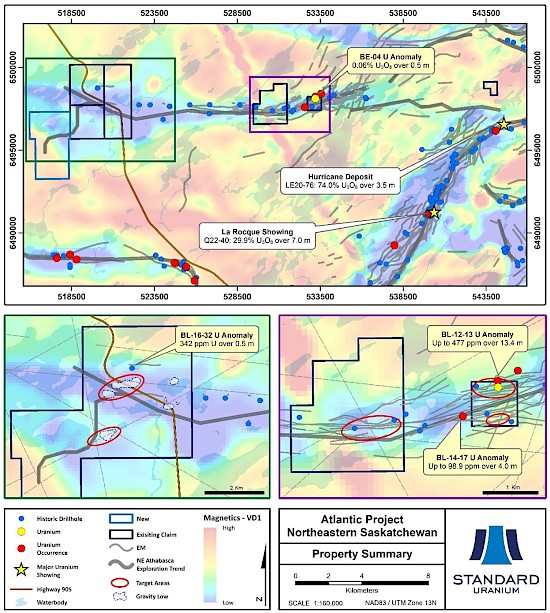
Figure 4. Plan map showing regional magnetics of the Atlantic project area and highlighting EM conductors coincident with cross-cutting faults and uranium intersections. Density-low anomalies identified from the 2022 gravity survey are highlighted on the western claim blocks in addition to the newly staked expansion.
Sun Dog Project
Standard Uranium holds a 100%-interest in the 19,604-hectare Sun Dog project along the northwestern edge of the Athabasca Basin (Figure 5). The Sun Dog project is comprised of 9 mineral claims located near Uranium City, and contains the historic Gunnar uranium mine in the Beaverlodge district where uranium was mined between 1953 and 1982.
The Sun Dog Project has been expanded by 1,502 hectares, adding an additional 6.75 km of NE-SW trending conductor strike length and additional surface uranium occurrences (Figure 5). The Company has completed two reconnaissance-scale drill programs on the project totalling 2,469 metres of diamond drilling in the winter of 2022 and 2023. Work to date is highlighted by the first drill hole at the Haven discovery, SD-23-013, which intersected 1.5 m of elevated radioactivity up to 1,300 cps associated with a strong hydrothermal alteration halo. Assay results from the winter 2023 drill program are currently being processed and will be released upon final approval and compilation.
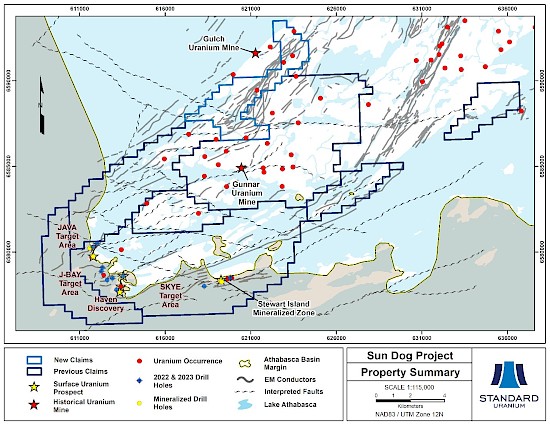
Figure 5. Plan map showing the expanded Sun Dog project area and highlighting EM conductors coincident with cross-cutting faults and uranium showings.
Davidson River Project
Davidson River is Standard Uranium’s flagship property, located in the southwest Athabasca uranium district of the Athabasca Basin, Saskatchewan, and encapsulates the inferred extension of the structural trend that hosts Fission Uranium’s Triple R deposit and NexGen Energy’s Arrow deposit (Figure 6). The project consists of 10 contiguous mineral dispositions totaling 30,737 hectares and lies approximately 25 to 30 km west of Arrow and Triple R, and 75 km south of the past producing Cluff Lake uranium mines.
The Company has completed 16,561 metres of diamond drilling in 39 drill holes on the Davidson River property since 2020, which has identified several zones of elevated uranium and clay-dravite alteration (Figure 7). Deep seated and strongly graphitic basement structures and favourable lithologies have been intersected across the four main trends on the property, emphasized by multiple stacked and reactivated graphitic shears and hydrothermal fluid flow on the Bronco trend, as well as a shallow highly prospective limonite-hematite redox alteration zone along the Thunderbird trend. Additionally, F3 Uranium’s recently discovered high-grade JR Zone (also situated west of the Clearwater Domain), is 20 km northeast of these shear zones and positioned along a conductor parallel to those found on the Davidson River property. This highlights the potential for the Davidson River property to host significant basement-hosted uranium mineralization and supports the Company’s theory that the uranium fertile conductors which host the Triple R and Arrow deposit are mirrored on the western side of the Clearwater Domain.
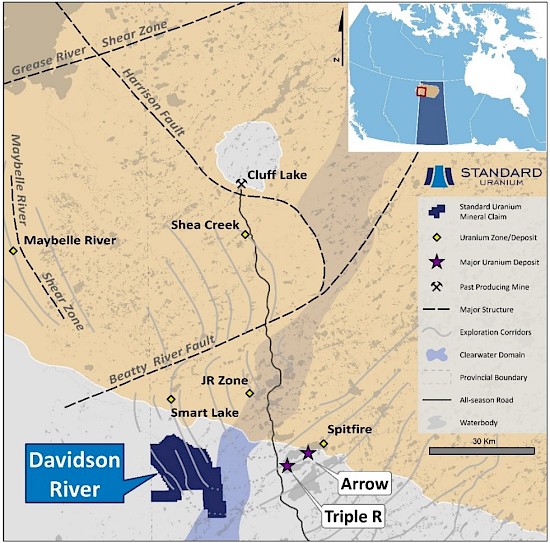
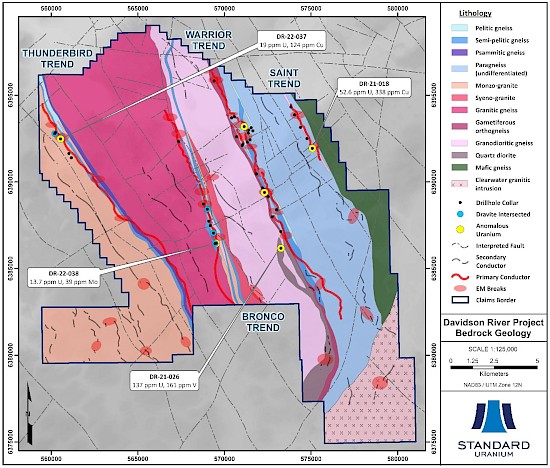
The Company believes the 2020-2022 diamond drilling programs have returned encouraging results on the property for uranium exploration in the emerging southwest Athabasca Basin district, and that the property contains several untested priority targets along the four major conductors that warrant further exploration. Data-driven analysis and anomaly matching of electromagnetic data by GoldSpot Discoveries has further refined the exploration strategy for high-grade basement hosted uranium mineralization on the property.
Canary Project
The Canary project comprises 2 mineral dispositions totalling 7,303 hectares, located along the Waterfound River in the Athabasca Basin. The project was acquired via staking in July 2020, and Standard Uranium holds a 100%-interest in the property.
Only one of the three conductive targets on the property has been tested by drilling, and results are considered highly anomalous. Historical drill-hole CRK-137 identified highly anomalous uranium enrichment near the unconformity with 10 ppm uranium over 7.4 metres in systematic composite sampling of the sandstone, and strong hydrothermal alteration was observed throughout the interval. Within this zone, a discrete 0.5 m sub-interval returned 103.1 ppm uranium; and a 1.0 m interval in the graphitic metasediments immediately below the unconformity returned 200 ppm uranium.
Exploration at the Canary project is early stage, and the project remains highly prospective for unconformity-related and basement hosted uranium mineralization. The ground-based DCIP resistivity survey completed by the Company in 2022 revealed several areas of low-resistivity anomalism paired with conductor disruptions, defining high-priority drill targets for an inaugural drill program on the project.
Ascent Project
Standard Uranium holds a 100%-interest in the Ascent project which straddles the eastern boundary of the Athabasca Basin. The project consists of a single mineral disposition totalling 3,737 hectares.
Regional prospecting by historical operators identified uranium enrichment in basement rocks located east of the Athabasca Basin edge, which support the exploration model for shallow sandstone and basement hosted uranium on the property. The high-resolution TDEM survey completed by the Company in 2022 has further resolved shallow geophysical conductors on the project, defining several priority drill targets for an inaugural drill program on the project.
The current exploration model for the Ascent project is analogous to that of the J-Zone and Roughrider deposits, that are located proximal to a similar airborne EM target that has dimensions of roughly 2-km long by 1-km wide. The Ascent EM target is interpreted by the Company to represent a shallow-dipping conductive system and will be the focus of future exploration programs, drawing on the analogy of the J-Zone and Roughrider uranium deposits.
Rocas Project
The Rocas project comprises 3 mineral dispositions totalling 3,152 hectares, located 75 kilometers southwest of the Key Lake Mine and Mill facilities along Highway 914, and approximately 72 kilometers south of the present-day margin of the Athabasca Basin. The project was acquired via staking in May 2023, and Standard Uranium holds a 100%-interest in the property.
The Project covers 5.5 kilometres of a northeast trending magnetic low/electromagnetic (EM) conductor corridor which hosts several uranium anomalies, including historical mineralized outcrop grab samples along approximately 900 metres of strike length, grading up to 0.50 wt. % U3O8. Notably, none of the historical uranium occurrences have been drill-tested. Data compilation by the Company has identified multiple target areas for shallow high-grade basement-hosted uranium mineralization within metasedimentary and orthogneissic basement rocks. The Project will benefit from additional surface sampling and geophysical surveys to aid in drill target vectoring.
Appointment of Sean Hillacre as President
The Company announces that Mr. Sean Hillacre, VP Exploration for the Company, has been appointed to President of the Company, effective July 1, 2023.
He will be working alongside Standard Uranium’s CEO Jon Bey as the Company advances its uranium projects in the prolific Athabasca Basin in Saskatchewan, in addition to supporting the Company's financing and strategic activities on a day-to-day basis.
The scientific and technical information contained in this news release, including the sampling, analytical and test data underlying the technical information contained in this news release, has been reviewed, verified, and approved by Sean Hillacre, P.Geo., VP Exploration of the Company and a “qualified person” as defined in NI 43-101.
Non-Brokered Private Placement
The Company also advises that it will not be proceeding with the private placement previously announced on May 4, 2023.
About Standard Uranium (TSX-V: STND)
We find the fuel to power a clean energy future
Standard Uranium is a uranium exploration company and emerging project generator poised for discovery in the world’s richest uranium district. The Company holds interest in over 176,969 acres (71,617 hectares) in the world-class Athabasca Basin in Saskatchewan, Canada. Since its establishment, Standard Uranium has focused on the identification, acquisition, and exploration of Athabasca-style uranium targets with a view to discovery and future development.
Standard Uranium’s Atlantic, Canary, Ascent, Corvo, and Rocas Projects, in the eastern Athabasca Basin, comprise twelve mineral claims over 20,964 hectares. The eastern basin projects are highly prospective for unconformity related and/or basement hosted uranium deposits based on historical uranium occurrences, recently identified geophysical anomalies, and location along trend from several high-grade uranium discoveries.
Standard Uranium's Sun Dog project, in the northwest part of the Athabasca Basin, Saskatchewan, is comprised of nine mineral claims over 19,603 hectares. The Sun Dog project is highly prospective for basement and unconformity hosted uranium deposits yet remains largely untested by sufficient drilling despite its location proximal to uranium discoveries in the area.
Standard Uranium’s Davidson River Project, in the southwest part of the Athabasca Basin, Saskatchewan, comprises ten mineral claims over 30,737 hectares. Davidson River is highly prospective for basement-hosted uranium deposits due to its location along trend from recent high-grade uranium discoveries. However, owing to the large project size with multiple targets, it remains broadly under-tested by drilling. Recent intersections of wide, structurally deformed and strongly altered shear zones provide significant confidence in the exploration model and future success is expected.
For further information contact:
Jon Bey, Chief Executive Officer, and Chairman
1030 West Georgia Street, Suite 907
Vancouver, BC V6E 2Y3
Tel:1 (306) 850-6699
E-Mail: info@standarduranium.ca
Cautionary Statement Regarding Forward-Looking Statements
This news release contains “forward-looking statements” or “forward-looking information” (collectively, “forward-looking statements”) within the meaning of applicable securities legislation. All statements, other than statements of historical fact, are forward-looking statements and are based on expectations, estimates and projections as of the date of this news release. Forward-looking statements include, but are not limited to, statements regarding: the timing and content of upcoming work programs; geological interpretations; timing of the Company’s exploration programs; and estimates of market conditions.
Forward-looking statements are subject to a variety of known and unknown risks, uncertainties and other factors that could cause actual events or results to differ from those expressed or implied by forward-looking statements contained herein. There can be no assurance that such statements will prove to be accurate, as actual results and future events could differ materially from those anticipated in such statements. Certain important factors that could cause actual results, performance or achievements to differ materially from those in the forward-looking statements are highlighted in the “Risks and Uncertainties” in the Company’s management discussion and analysis for the fiscal year ended April 30, 2022, dated August 26, 2022.
Forward-looking statements are based upon a number of estimates and assumptions that, while considered reasonable by the Company at this time, are inherently subject to significant business, economic and competitive uncertainties and contingencies that may cause the Company’s actual financial results, performance, or achievements to be materially different from those expressed or implied herein. Some of the material factors or assumptions used to develop forward-looking statements include, without limitation: the future price of uranium; anticipated costs and the Company’s ability to raise additional capital if and when necessary; volatility in the market price of the Company’s securities; future sales of the Company’s securities; the Company’s ability to carry on exploration and development activities; the success of exploration, development and operations activities; the timing and results of drilling programs; the discovery of mineral resources on the Company’s mineral properties; the costs of operating and exploration expenditures; the presence of laws and regulations that may impose restrictions on mining; employee relations; relationships with and claims by local communities and indigenous populations; availability of increasing costs associated with mining inputs and labour; the speculative nature of mineral exploration and development (including the risks of obtaining necessary licenses, permits and approvals from government authorities); uncertainties related to title to mineral properties; assessments by taxation authorities; fluctuations in general macroeconomic conditions.
The forward-looking statements contained in this news release are expressly qualified by this cautionary statement. Any forward-looking statements and the assumptions made with respect thereto are made as of the date of this news release and, accordingly, are subject to change after such date. The Company disclaims any obligation to update any forward-looking statements, whether as a result of new information, future events or otherwise, except as may be required by applicable securities laws. There can be no assurance that forward-looking statements will prove to be accurate, as actual results and future events could differ materially from those anticipated in such statements. Accordingly, readers should not place undue reliance on forward-looking statements.
Neither the TSX-V nor its Regulation Services Provider (as that term is defined in the policies of the TSX-V) accepts responsibility for the adequacy or accuracy of this release.

